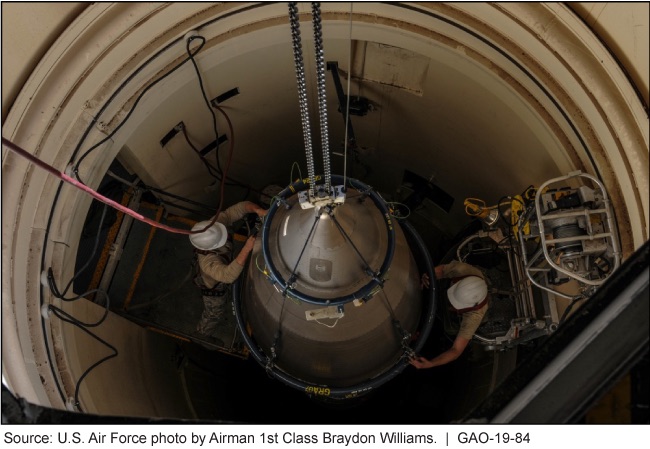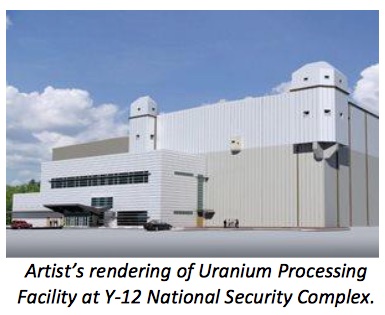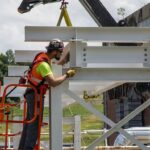
U.S. Air Force missile maintainers working on an intercontinental ballistic missile. (Source: U.S. Air Force photo by Airman 1st Class Braydon Williams/GAO-19-84)
The National Nuclear Security Administration is preparing to restart a program to replace the W78 nuclear warhead, and new facilities at the Y-12 National Security Complex could be important to that project, a federal agency said Friday.
The W78 is one of two types of warheads on U.S. Air Force intercontinental ballistic missiles. The W87 is the other.
Critical components inside the W78 are aging, according to the U.S. Government Accountability Office, which published a report about the warhead replacement program on Friday. Also, the military’s requirements for, among other things, the safety and security features of the warhead have changed since it entered the stockpile in 1979, the GAO said.
Besides being used by the Air Force, the replacement W78 warhead could be used in ballistic missiles launched from Navy submarines, although further studies are required, the GAO said.
The two Y-12 facilities that could affect the warhead replacement program are the Uranium Processing Facility, which is now under construction, and the Lithium Production Facility, which could have a new building through a project that is still in the planning stages.
The UPF is except to be completed by the end of 2025, about four years before the scheduled delivery of the first production unit of the W78 replacement warhead. The GAO said the W78 program goal is to produce the first replacement warhead in fiscal year 2030.
The UPF, which is being built on the west side of Y-12, is expected to cost no more than $6.5 billion, and it will replace operations that now take place in older Y-12 buildings such as 9212. UPF will help ensure that the NNSA can produce uranium components for the W78, the GAO said.
The other building, the Lithium Production Facility, could be built on the east side of Y-12, possibly where the Biology Complex is now. The GAO said the NNSA will require lithium for the W78 replacement warhead. But the United States no longer maintains full lithium production facilities and relies on recycling to provide lithium for nuclear weapon systems, the GAO said.
The existing lithium processing facility, Building 9204-2 on the west side of Y-12, is more than 70 years old, and it is one of the oldest operating facilities in the nuclear security enterprise, according to the NNSA. Federal officials have already approved the need for the new Lithium Production Facility.
The GAO said the NNSA has analyzed options to build the Lithium Production Facility, and a conceptual design effort is next, with an estimated completion date of fiscal year 2027.
“Until the facility is available, NNSA has developed a bridging strategy to fill the interim supply gaps,” said the GAO report, signed by Allison B. Bawden, director of natural resources and environment.
The two Y-12 buildings are cited in the report as examples of NNSA activities to build or repair facilities and capabilities that will provide nuclear or non-nuclear components for the W78 replacement warhead. The building and repair activities could affect the cost, schedule, or production capacity of the warhead replacement program, the GAO said.
Another building cited in the report is a facility at Sandia National Laboratories that produces custom, strategic radiation-hardened microelectronics for nuclear weapons, allowing them to function reliably in a range of operational environments. In August, NNSA officials said that facility, known as Microsystems and Engineering Sciences Applications, can remain viable until 2040, but it would need additional investments.
A comprehensive coordination effort will be required to ensure that the facilities and capabilities are ready to provide components for the warhead by the end of the 2020s, the GAO report said, citing the W78 replacement program manager.
“Because these activities are separately managed and supported outside the W78 replacement program, NNSA considers progress on them to represent a critical external risk to the program,” the GAO said. “NNSA is taking or plans to take some action to mitigate this external risk at the program and agency level. One step that the program plans to take to address this risk is to draft formal agreements—called interface requirements agreements—with other NNSA program offices that oversee the deliverables and schedules for the design, production, and test facilities that are needed for the program. These agreements describe the work to be provided by these external programs, including milestone dates for completing the work, funding, and any risks to cost, schedule, or performance.”

Image from the National Nuclear Security Administration’s Fiscal Year 2018 Stockpile Stewardship and Management Plan
The GAO said the NNSA and U.S. Department of Defense have wanted to update the aging W78 nuclear warhead used by the Air Force for almost a decade. The program to replace the warhead is known as a life extension program. It was suspended in fiscal year 2014, in part because of budget constraints, the GAO said. That program was evaluating whether the warhead could also be used by the U.S. Navy.
Now, the NNSA has been directed by the 2018 Nuclear Posture Review to restart the warhead replacement program for the Air Force in fiscal year 2019, which began October 1. The Nuclear Posture Review, which revised nuclear weapons policy and programs, also directed NNSA and the Navy to evaluate whether the Navy could use the W78 warhead, the GAO said.
The NNSA has assessed 126 technologies that could be used in the W78 replacement, the GAO said. Nine of those would replace obsolete technologies or technologies or materials that are no longer available. They are considered “must-do” because they are the only technologies or materials available to meet minimum warhead requirements established by the NNSA and Department of Defense, the GAO said.
The combined program could cost about $10 billion to $15 billion, according to the NNSA’s most recent estimate, which was reported in October, the GAO said.
NNSA and DOD use the life extension programs to refurbish or replace nuclear weapon components, extend the life of the weapons, and enhance the safety and security of the nation’s nuclear weapons stockpile. The NNSA currently has four modernization programs under way. It’s the busiest the NNSA has been since the Cold War era, Administrator Lisa Gordon-Hagerty said in a report to Congress in October. The programs include work at Y-12. (See this story for more information.)
All weapons in the U.S. nuclear stockpile are two-stage nuclear weapons, or thermonuclear weapons. The first stage, known as the primary, is a fission device that is the initial source of nuclear energy. The secondary, which is the second stage, is a nuclear stage physically separate from the primary. The secondary provides extra energy release, and it is activated by energy from the primary. The nuclear components, which include the primary and a secondary enclosed within a radiation case, are referred to as the nuclear explosive package. When detonated, these nuclear components produce the weapon’s explosive force, or “yield,†the GAO said.
Y-12 is one of the NNSA’s four production plants, and it generally produces the secondary and radiation case, the GAO said.
Besides the nuclear components, a ballistic missile nuclear warhead like the W78 also has non-nuclear components. The parts are enclosed within an aeroshell supplied by either the Air Force or the Navy, the GAO said. The non-nuclear components within the weapon control and support the detonation sequence and help ensure its safety and security from human tampering and from environmental effects, the GAO said.

Federal officials have already approved the need for a new Lithium Production Facility at the Y-12 National Security Complex, and in May 2018, they said it could be built on the east side of the 811-acre plant, possibly where the Biology Complex, the brick building at center, is now. The east side of Y-12 is pictured above from Scarboro Road on Sunday, May 20, 2018. (Photo by John Huotari/Oak Ridge Today)
After assembly, the NNSA, which is part of the U.S. Department of Energy, provides warheads to the U.S. Air Force and U.S. Navy, which are part of the U.S. Department of Defense, for use in the military’s weapons delivery systems.
The NNSA oversees three national security laboratories that are involved in nuclear weapons design: Lawrence Livermore in California, Los Alamos in New Mexico, and Sandia in California and New Mexico.
Besides Y-12, the other production plants are the Pantex Plant in Texas, Kansas City National Security Campus in Missouri, and Savannah River Site in South Carolina.
It’s not clear yet how nuclear weapons policies and programs might change after the Democrats, who gained a majority in the November 6 election, take control of the U.S. House of Representatives early next year, or whether the W78 replacement program could be affected.
In November, DefenseNews reported that Representative Adam Smith, who is set to become the next chairman of the House Armed Services Committee in the new Congress, and other Democratic lawmakers said they hope to use their party’s takeover of the House to check the Trump administration’s expansive policies toward nuclear weapons. Among other things, Smith, a Washington Democrat, said he wants to see a redo of the Trump administration’s Nuclear Posture Review, continue multilateral nuclear pacts, and advance a no-first-use policy toward nuclear weapons for the United States, DefenseNews reported.
See the GAO report here.
More information will be added as it becomes available.
Most news stories on Oak Ridge Today are free, brought to you by Oak Ridge Today with help from our advertisers, contributors, and subscribers. This is a free story. Thank you to our advertisers, contributors, and subscribers. You can see what we cover here.
Do you appreciate this story or our work in general? If so, please consider a monthly subscription to Oak Ridge Today. See our Subscribe page here. Thank you for reading Oak Ridge Today.
Copyright 2018 Oak Ridge Today. All rights reserved. This material may not be published, broadcast, rewritten, or redistributed.





Leave a Reply